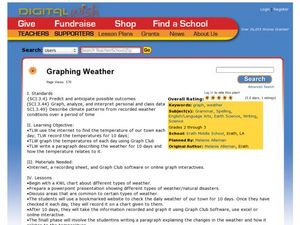Curated OER
The Renaissance
Students encounter having been chosen to join a group of renowned historians who have been offered an unprecedented opportunity. They travel back in time to the Renaissance time period. Students research one aspect of that time period....
Curated OER
Reduce, Reuse, Recycle
Students brainstorm and share opinions about products that can be reused or recycled after reading the article, "Seattle's Recycling Success Is Being Measured in Scraps." They then investigate, analyze and evaluate articles on recycling...
Curated OER
Integrated Video Technology
High schoolers create a Mother's Day video gift by utilizing the latest video technology in class. In this film making instructional activity, students utilize important photographs related to their mother and import them into a...
Curated OER
Cool Commercials Critique
Students investigate advertising by critiquing commercials in class. In this media lesson, students view several commercials on their computers while completing a worksheet which helps them critique the ads. Students define several...
Curated OER
Our World With MapsQ
Learners examine and compare different types of maps. In this map skill lesson, students look at neighborhood and national maps on the overhead projector while making comparisons of the symbols and locations. They use a T-chart to record...
Curated OER
Animal Morphs
Students explore animal drawing. For this cross curriculum drawing, photography, and animals lesson, students combine computer drawing and freehand drawing to create an animal and its environment using a photograph of their own face...
Curated OER
Save the Animals!
Learners research an endangered animal and share what they learned through the use of technology. In this interdisciplinary lesson plan on animals, students conduct research on an endangered animal. Then, learners create a PowerPoint...
Curated OER
Genealogy through Technology
Young scholars research their family history. In this genealogy lesson, students research their own family. Young scholars use storyboarding to organize their information. After gathering information students create a Powerpoint...
Curated OER
All About Me!
Students write about themselves. In this descriptive writing lesson, students view a PowerPoint for examples of descriptive writing and then write sentences describing themselves. Students use a computer program to type their sentences...
Curated OER
Simple Machines Scavenger Hunt
Third graders examine machinery in the modern world by completing a scavenger hunt. In this technology lesson, 3rd graders utilize a computer to view photographs of simple machines they must locate. Students take photographs with a...
Curated OER
Advertise a State Vacation
Young scholars create a brochure advertising a state for vacation. In this internet research lesson, students do research on a state and create a brochure with the information. Young scholars write a commercial and videotape them.
Curated OER
Forms in Architecture
Students explore shapes and forms in architecture. This lesson also introduce students to the concepts of form and function in architecture. They take an architectural tour (on foot or with visuals) to identify forms and shapes.
Curated OER
Becoming Africa's Wildlife
Students take a "trip" to Africa. In this Africa activity, students watch a National Geographic video on animals from Africa. They pick an animal to research, create a poster about, and make a field guide.
Curated OER
Cultures and Cuisines WebQuest
Learners create and present a powerpoint presentation. In this cultures and cuisines research lesson, students select a country, interview someone from that country and visit a restaurant from that country. Learners complete research...
Curated OER
Sim's Cities
Young scholars investigate city management and government by creating a fictional city in groups. In this civics instructional activity, students create rules and a mascot for their fictitious city which they create from poster board...
Curated OER
Biography Report- Learning Microsoft Word
Students learn how to use Microsoft Word. In this biography lesson, students participate in mini-lessons on key features of Microsoft Word and then use it to write a multi-part biography report.
Curated OER
Creating with Publisher
Learners create a book cover using Microsoft Publisher. For this computer publishing lesson, students learn how to use the program Microsoft Publisher. Learners experiment with fonts, styles, formats and clip art. Students use what...
Curated OER
Graphing Weather
Students make a graph. In this weather lesson plan, students fill in a KWL chart about different types of weather. Students watch a PowerPoint presentation about weather and natural disasters and where these types of weather are common....
Positively Autism
"The Napping House" Big and Little
The dog is big. The mouse is little. Using vocabulary words introduced in the previous lesson, kids read, or are read, sentences and examine images that contrast big and little.
Positively Autism
"Decorating Easter Eggs" Social Skill Story
Prepare kids for Easter egg decorating with a social skills story that explains the process and details appropriate behavior for the activity.
Positively Autism
Fourth of July Vocabulary
Flag, fireworks, parade. Introduce learners with autism to nine words associated with the Fourth of July. Each word is illustrated with either a photograph or drawing.
Teach Engineering
The Fibonacci Sequence and Robots
What better way to introduce the idea of a sequence than with robots! An educational lesson explains the classic Fibonacci sequence before pupils build and program a robot to move. Additionally, the lesson challenges individuals to...
Teach Engineering
Maker Challenge: Adding Helpful Carrier Devices to Crutches
Make breaking a leg a less troublesome experience. Groups brainstorm designs for crutches that have devices that help carry items. They build prototypes of their devices to test out their designs.
Teach Engineering
Earthquakes Living Lab: Finding Epicenters and Measuring Magnitudes
Pairs use an online simulation to determine the epicenter and magnitude of an earthquake. Using real data about the earthquake's maximum S wave amplitudes, they then determine the magnitude. The resource provides a great career...

























